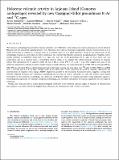Files in this item
Holocene volcanic activity in Anjouan Island (Comoros archipelago) revealed by new Cassignol-Gillot groundmass K–Ar and 14C ages
Item metadata
| dc.contributor.author | Quidelleur, Xavier | |
| dc.contributor.author | Michon, Laurent | |
| dc.contributor.author | Famin, Vincent | |
| dc.contributor.author | Geffray, Marie-Charlotte | |
| dc.contributor.author | Danišík, Martin | |
| dc.contributor.author | Gardiner, Nicholas | |
| dc.contributor.author | Rusquet, Anaïs | |
| dc.contributor.author | Zakaria, Mohamed Gou | |
| dc.date.accessioned | 2023-04-25T09:30:06Z | |
| dc.date.available | 2023-04-25T09:30:06Z | |
| dc.date.issued | 2022-02-01 | |
| dc.identifier | 276101542 | |
| dc.identifier | 426b7500-8254-4ab5-ab7c-35a259b193c5 | |
| dc.identifier | 85116372563 | |
| dc.identifier | 000708679100001 | |
| dc.identifier.citation | Quidelleur , X , Michon , L , Famin , V , Geffray , M-C , Danišík , M , Gardiner , N , Rusquet , A & Zakaria , M G 2022 , ' Holocene volcanic activity in Anjouan Island (Comoros archipelago) revealed by new Cassignol-Gillot groundmass K–Ar and 14 C ages ' , Quaternary Geochronology , vol. 67 , 101236 . https://doi.org/10.1016/j.quageo.2021.101236 | en |
| dc.identifier.issn | 1871-1014 | |
| dc.identifier.other | RIS: urn:631BFEEDCC46A0C460668276BC64EFC0 | |
| dc.identifier.other | ORCID: /0000-0003-3465-9295/work/100901682 | |
| dc.identifier.uri | https://hdl.handle.net/10023/27464 | |
| dc.description | This research was funded by the CNRS/INSU TELLUS “MAYVOLTE” grant. | en |
| dc.description.abstract | The Comoros archipelago has attracted renewed attention since 2018 due to the submarine volcano growing east of the island of Mayotte and the associated ongoing seismic crisis. However, the origin of Comorian magmatism remains controversial, as it is either interpreted as related to a hotspot trail, to a fracture zone, or to a plate boundary. Lying in the central part of the archipelago, Anjouan is a key island to better understand the relationship between volcanism and geodynamics. Together with a careful selection of published whole-rock K–Ar ages, our new set of 13 groundmass K–Ar ages on lava flows and one radiocarbon age on a charcoal from a strombolian deposit, allow us to reassess the volcano-tectonic evolution of Anjouan Island. New groundmass K–Ar ages lie within the last 1 Ma, i.e. from 899 ± 14 to 11 ± 1 ka. They suggest that most of the subaerial volcanism in Anjouan is much younger than previously inferred, and occurred as pulses at 900–750 ka, perhaps 530 ka, 230–290 ka, and since 60 ka, with erosional periods in between. Among our new data, one 14C age of 7513–7089 yrs calBCE (9.3 ± 0.2 ka) and five K–Ar ages younger than 60 ka show that recent volcanism occurred in Anjouan. Moreover, the concentration of eruptive vents along a N150° alignment, parallel to the maximum horizontal stress, suggests a strong link between regional tectonics and volcanism. Considering the presence of active volcanoes on both the western and eastern extremities of the Comoros archipelago, our discovery of Holocene activity on Anjouan provides strong arguments against a chronological progression of volcanism along the archipelago, and therefore contradicts the hotspot hypothesis for the origin of volcanism. Finally, this study provides a robust geochronological timeframe of the different volcanic stages of Anjouan. It demonstrates that Anjouan is an active island and suggests that volcanism and tectonics can both resume at any time. | |
| dc.format.extent | 11 | |
| dc.format.extent | 7952700 | |
| dc.language.iso | eng | |
| dc.relation.ispartof | Quaternary Geochronology | en |
| dc.subject | Comoros archipelago | en |
| dc.subject | Anjouan | en |
| dc.subject | K–Ar | en |
| dc.subject | 14 C | en |
| dc.subject | Holocene volcano-tectonics | en |
| dc.subject | GB Physical geography | en |
| dc.subject | DAS | en |
| dc.subject | AC | en |
| dc.subject | MCC | en |
| dc.subject.lcc | GB | en |
| dc.title | Holocene volcanic activity in Anjouan Island (Comoros archipelago) revealed by new Cassignol-Gillot groundmass K–Ar and 14C ages | en |
| dc.type | Journal article | en |
| dc.contributor.institution | University of St Andrews. School of Earth & Environmental Sciences | en |
| dc.identifier.doi | 10.1016/j.quageo.2021.101236 | |
| dc.description.status | Peer reviewed | en |
| dc.date.embargoedUntil | 2022-09-29 |
This item appears in the following Collection(s)
Items in the St Andrews Research Repository are protected by copyright, with all rights reserved, unless otherwise indicated.

